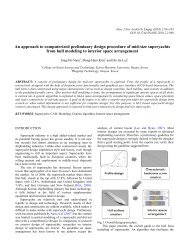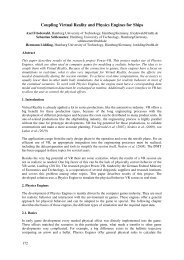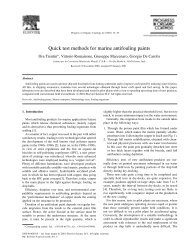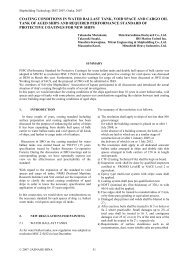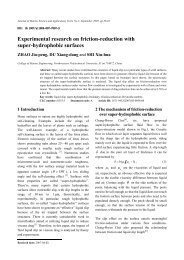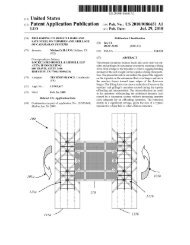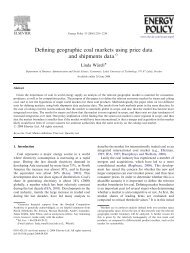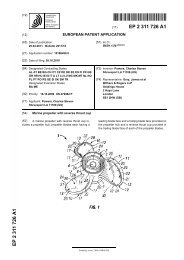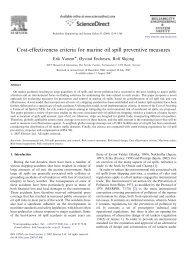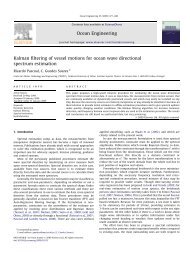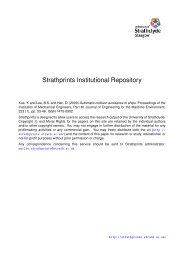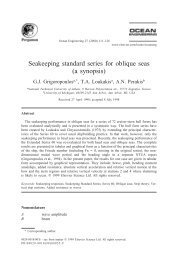Buckling of thin-walled conical shells under uniform external pressure
Buckling of thin-walled conical shells under uniform external pressure
Buckling of thin-walled conical shells under uniform external pressure
You also want an ePaper? Increase the reach of your titles
YUMPU automatically turns print PDFs into web optimized ePapers that Google loves.
finite length which were subjected to combined axial and<br />
<strong>external</strong> <strong>pressure</strong>. They showed that this behavior is<br />
dependant on geometry, loading and initial imperfections.<br />
Also Yamaki [8] has studied the nonlinear behavior <strong>of</strong><br />
<strong>external</strong>ly pressurized cylindrical <strong>shells</strong> and effects <strong>of</strong><br />
geometrical imperfections. Further, other authors have<br />
studied stability <strong>of</strong> the <strong>shells</strong> that are outlined in the<br />
perspective to come.<br />
Performing test on manufactured specimens is the most<br />
steadfast method in engineering researches. In this paper,<br />
six frusta and four shallow <strong>conical</strong> cap (SCC) specimens<br />
have been manufactured and tested <strong>under</strong> the effect <strong>of</strong><br />
<strong>uniform</strong> <strong>external</strong> <strong>pressure</strong>. The material consisted <strong>of</strong> mild<br />
steel with yield stress <strong>of</strong> 277 MPa [9]. Boundary conditions<br />
are all simply supported in which only a radial constraint is<br />
provided at the edges. A loading <strong>of</strong> <strong>uniform</strong> <strong>external</strong><br />
<strong>pressure</strong> is produced by gauged vacuum pump using<br />
suction process. The stages <strong>of</strong> prebuckling, initial buckling,<br />
overall buckling and collapse have been observed and<br />
evaluated and nonlinear response <strong>of</strong> these <strong>conical</strong> <strong>shells</strong> has<br />
been studied.<br />
2. Experimental syllabus<br />
2.1. Model size<br />
In deciding on the model size for testing, a number <strong>of</strong><br />
issues were considered. Firstly, the models should not be<br />
too large, to avoid any undesirable inconveniences<br />
associated with laboratory testing. Secondly, the models<br />
should not be too small, so as to cause difficulties in their<br />
fabrication. Thirdly, the radius-to-thickness ratios (R/t) <strong>of</strong><br />
the models should be analogous to those used in realistic<br />
structures, since the effect <strong>of</strong> interaction between yielding<br />
and buckling needs to be appropriately captured in the<br />
tests. Typical real values for the R/t ratio are wi<strong>thin</strong> the<br />
range <strong>of</strong> 300–1000. As <strong>thin</strong> steel sheets <strong>of</strong> 0.5 mm and<br />
above can be easily obtained, welded or soldered effortlessly<br />
to produce high quality models with special welding<br />
machine or soldering apparatus, it was decided that the<br />
models ought to be <strong>of</strong> 600 mm in diameter. Consequently,<br />
Table 1<br />
Dimensions and aspect ratios <strong>of</strong> the specimens<br />
Specimen code Thickness t<br />
(mm)<br />
ARTICLE IN PRESS<br />
B.S. Golzan, H. Showkati / Thin-Walled Structures 46 (2008) 516–529 517<br />
Top radius<br />
(mm)<br />
Bottom radius<br />
(mm)<br />
proper (R/t) ratios can be achieved with different steel<br />
sheet thicknesses.<br />
2.2. Test specimens<br />
In this paper, six different frusta specimens were used,<br />
namely SC1, SC2, SC3, SC4, SC5, SC6 along with four<br />
SCC specimens represented by SCC1, SCC2, SCC3,<br />
and SCC4. . The properties <strong>of</strong> all models are outlined in<br />
Table 1. The thickness <strong>of</strong> specimens is totally constant. The<br />
frusta specimens have the same lower base diameter <strong>of</strong><br />
600 mm whereas the top base <strong>of</strong> the first three measures<br />
200 mm in diameter and in the second three it is 100 mm.<br />
The SCC specimens have the same lower base diameter <strong>of</strong><br />
600 mm except for SCC3 with a base diameter equal to<br />
500 mm. For the detailed geometry and slenderness ratios<br />
<strong>of</strong> specimens refer to Table 1. Edge conditions are all<br />
simply supported, in which only radial restraint was<br />
provided.<br />
Three tensile coupon tests were performed identically to<br />
obtain the properties <strong>of</strong> material. The yield and failure<br />
stresses <strong>of</strong> this mild steel are 277 and 373 Mpa, correspondingly.<br />
The Young modulus acquired, equals 210 GPa.<br />
Each specimen was assembled by cord-oriented welding<br />
over the rolled sheet fragment edges, as is shown in Fig. 1.<br />
A loading <strong>of</strong> <strong>uniform</strong> <strong>external</strong> <strong>pressure</strong> is produced by<br />
gauged vacuum pump using suction process.<br />
2.3. Fabrication modus operandi<br />
An important issue in shell buckling experiments is the<br />
fabrication <strong>of</strong> good quality specimens, including the choice<br />
<strong>of</strong> material and fabrication method. Many fabrication<br />
techniques have been developed [10,11], among which are<br />
electr<strong>of</strong>orming (making duplicates by electroplating metal<br />
onto a mold <strong>of</strong> an object, then removing the mold in which<br />
the intricate surface details are precisely reproduced by this<br />
process), thermal forming <strong>of</strong> plastics (PVC, polyethylene,<br />
Lexan, or other materials) and cold working <strong>of</strong> metal<br />
(spinning, explosive forming, or hydr<strong>of</strong>orming). Most <strong>of</strong><br />
these are specialized laboratory techniques for fabricating<br />
nearly perfect model <strong>shells</strong>. Where tests are intended to<br />
Height h<br />
(mm)<br />
Semi-vertex<br />
angle (a)<br />
R/t R/r L/R L ¼ slant<br />
length<br />
SC1 0.6 100 300 223.6 41.81 500 3 1<br />
SC2 0.6 100 300 403.2 26.36 500 3 1.5<br />
SC3 0.6 100 300 565.7 19.47 500 3 2<br />
SC4 0.6 50 300 165.8 56.44 500 6 1<br />
SC5 0.6 50 300 374.2 33.75 500 6 1.5<br />
SC6 0.6 50 300 545.4 24.62 500 6 2<br />
SCC1 0.5 – 300 60 78.69 600 – 1.02<br />
SCC2 0.8 – 300 60 78.69 375 – 1.02<br />
SCC3 0.5 – 250 62.5 75.96 500 – 1.03<br />
SCC4 0.8 – 300 75 75.96 375 – 1.03



